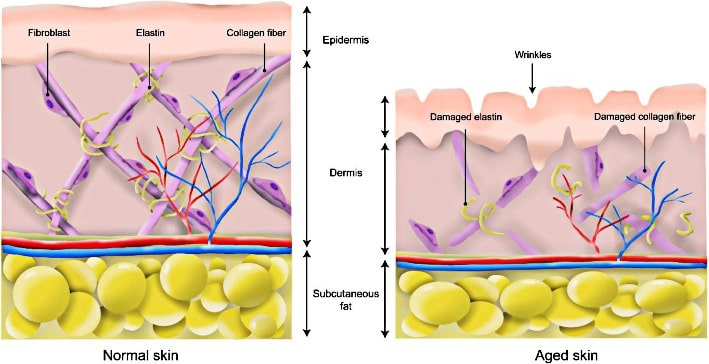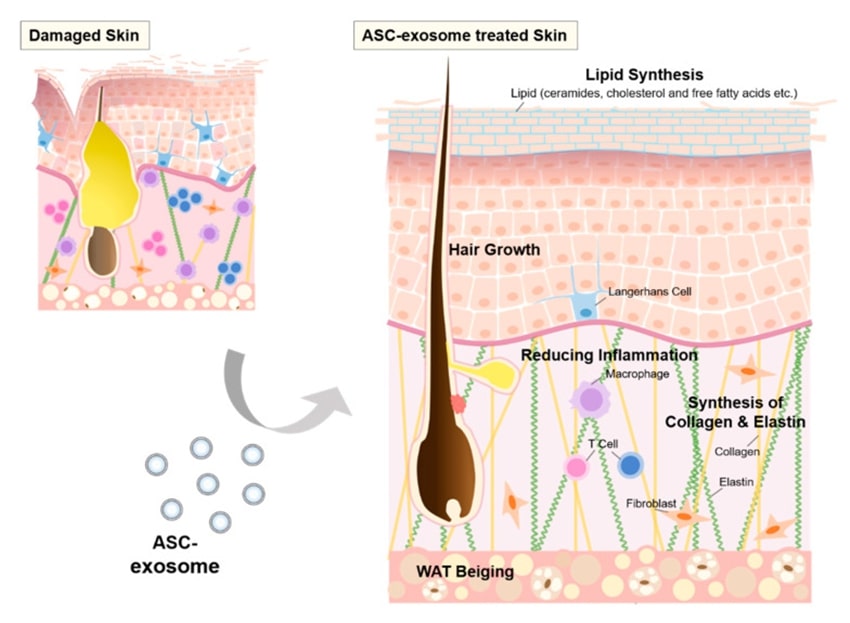Exosomes for Skin Care
Exosomes secreted by different tissue cells are structurally similar, while differing in the composition of the surface proteins and intra-vesicular components they carry, indicating the unique biological role of exosomes, whose function depends mainly on the parent cell from which they originate. Creative Biolabs is committed to providing highly purified exosomes and research services for skin care applications, and to promoting the clinical translation of exosomes.
Characteristics of Exosomes
Exosomes have been shown to play a key role not only in cell communication, migration, proliferation and aging because of their ability to carry unique proteins, nucleic acids and lipid components that respond to the characteristics of the producing cells, but there are also many studies and reports on their application as cell-free therapies in skin care and repair. Firstly, exosomes can inhibit TNF-induced inflammatory responses, secondly, miRNAs and lncRNAs carried by exosomes in response to their sources can be used for early diagnosis of diseases and screening of prognostic biomarkers, furthermore, due to their ability to escape the immune and phagocytic systems, exosomes become biocompatible drug delivery carriers that bind to their targets through membrane surface specific proteins to accomplish signal transduction and substance transport, altering the fate of the target cells.
Stem cell-derived exosomes are cell-free bilayer lipid membrane-enclosed vesicles secreted by stem cells and mainly include exosomes from mesenchymal stem cells (MSCs), adipose stem cells (ASCs) and pluripotent stem cells (iPSCs). In addition to morphological and structural similarities to other sources of exosomes, stem cell-derived exosomes have the unique ability to promote cell proliferation, vascular regeneration and skin repair due to the specificity of their membrane surface proteins and intramembrane carrying substances. As the list of delivered miRNAs involved in skin health maintenance gradually grows, research on the transformation of stem cell-derived exosomes into skin microenvironment, skin rejuvenation and wound repair applications will also expand.
Applications in Skin Aging
In addition to genetically determined age-dependent intrinsic or genetically programmed aging, skin aging is predominantly photoaging caused by environmental exogenous factors. Ultraviolet B (UVB) promotes the expression of Aging-associated-galactosidase and Metalloproteinases (MMPs) by stimulating MAPK signaling pathway, and induces DNA mutation and indirect oxidative stress by enhancing activator protein-1 (AP-1) signaling, thereby inhibits the formation of type I collagen (Col 1), leading to cellular damage. Human dermal fibroblast cells (HDFs) and their extracellular matrix (ECM) are key indicators of skin rejuvenation, and HDFs synthesize ECM, which includes collagen, elastin and hyaluronic acid, exclusively in the dermal skin layer. When aging fibroblasts do not produce enough collagen to maintain tissue elasticity and moisture, accompanied by accelerated collagen breakdown by high levels of MMPs, the synthesis of Col 1 and Col 3 will decrease, leading to molecular structural features of skin aging such as collagen fracture and external manifestations of skin aging such as the appearance of wrinkles.
The effect of stem cell-derived exosomes on delaying fibroblast senescence has been reported by numerous sources. For example, iPSCs-derived exosomes (iPSCs-EXO) reduce the high expression level of MMP-1/3 in HDFs transmitted in vitro for more than 30 generations, and promote the expression of type I collagen and the proliferation and migration ability of HDFs. At the same time, when highly purified iPSCs-EXO was applied to MSCs with high levels of reactive oxygen (ROS), it also attenuated the senescence phenotype by reversing high levels of ROS. Cross-corroboratingly, exosomes derived from ASCs significantly inhibited the induction of high levels of MMP-1/2/3/9 expression by UVB irradiation through PI3K/Akt signaling pathway and promoted the expression of tissue inhibitor of metalloproteinases (TIMP)-1 and transforming growth factor (TGF)-β1, thereby reducing DNA damage by photoaging and delaying cellular senescence.
 Fig.1 The structures of the skin before and after aging. (Yang, 2021)
Fig.1 The structures of the skin before and after aging. (Yang, 2021)
Applications in Skin Repair and Regeneration
The process by which exosomes promote skin repair and regeneration involves a series of coordinated activities, including cell proliferation, angiogenesis, collagen deposition, tissue remodeling and inflammatory response. For example, exosomes from human bone marrow-derived MSCs suppress the inflammatory response by reducing the number of inflammatory neutrophils and inhibiting the recruitment and local accumulation of macrophages. Human cord blood-derived MSCs highly express miR-21-3p, and their exosomes can stimulate the exertion of β-catenin activity via the wint4 pathway, thereby promoting the proliferation, migration and formation of endothelial fibroblasts, as well as by decreasing sprout homologue 1 (Spry1) and phosphatase and tensin homologue (PTEN) levels and increasing angiopoietin-2 levels to induce wound closure rate and reduce scar formation. Meanwhile, fetal dermal mesenchymal stem cell (FDMSC)-derived exosomes are involved in activating the Notch pathway and enhancing the motility and secretory capacity of HDFs, which have the potential to promote wound healing. Scar-free healing is the ultimate goal of skin repair and is distinguished from scar tissue, which has finer reticular collagen, less cross-linking, and fewer myofibroblasts, while having as little inflammatory response as possible. The main cells involved in scar formation are myofibroblasts, which are activated to form early proliferative scars and lose the ability to differentiate into normal epithelial cells and fibroblasts, while late and chronic scars are formed mainly by the continued proliferation of activated keratinocytes in areas of fibrotic scarring. Studies have shown that exosomes derived from ASCs and exosomes derived from MSCs overexpressing tumor-stimulating gene-6 (TSG-6) both reduce scar formation by decreasing inflammation and myofibroblast proliferation. Furthermore, M2 macrophage-derived exosomes may affect scar formation by participating in the inhibition of miR-200C3p in fibroblasts, which is a strong evidence that exosomes mediate cellular communication in the treatment of keloid hyperplasia.
 Fig.2 Effects of ASCs-derived exosomes on skin. (Ha, 2020)
Fig.2 Effects of ASCs-derived exosomes on skin. (Ha, 2020)
All the above studies have shown that exosomes can be widely studied and applied in skin care and regenerative repair as a non-invasive treatment to promote the proliferation and migration of HDFs, enhance the angiogenic activity of endothelial cells, and reduce scar formation. Creative Biolabs can provide you with various exosome-related products and services with our mature technical service platform and professional team. Please contact us to inform you of your needs.
References
-
Yang, G.H.; et al. Overcome the barriers of the skin: exosome therapy. Biomater Res. 2021, 25(1): 22.
-
Ha, D.H.; et al. Mesenchymal stem/stromal cell-derived exosomes for immunomodulatory therapeutics and skin regeneration. Cells. 2020, 9(5): 1157.
For Research Use Only. Cannot be used by patients.
Related Services:

 Fig.1 The structures of the skin before and after aging. (Yang, 2021)
Fig.1 The structures of the skin before and after aging. (Yang, 2021)
 Fig.2 Effects of ASCs-derived exosomes on skin. (Ha, 2020)
Fig.2 Effects of ASCs-derived exosomes on skin. (Ha, 2020)









